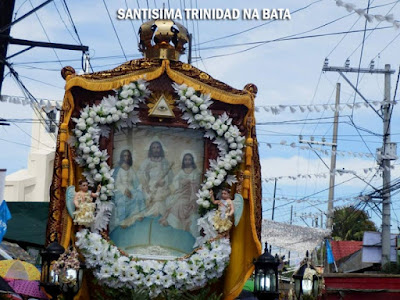 |
| THE MYSTERY PICTURE OF STA, SALOME, ca. 1920s. |
A decade ago, in one of my visits to a local antique
dealer, I picked up this photo postcard of what seemed to be a family before an
heirloom wooden statue of Sta. Salome, on a small wooden carroza. The people
are dressed in modest clothes, in their Sunday’s best—nothing expensive or
flashy. The women on the left looked like they were in mourning clothes,
indicating a death in the family, maybe the pater familia. The grove of slender
bamboos in the background gives the scene a real, rustic feel. It would appear
that they are about to leave for a procession.
I liked how this 1920s photo evoked the spirit of bygone days in the
province, —simple, unhurried, when people’s devotion to their faith was deeper,
more unwavering.
But what drew me to the picture was Sta. Salome herself. It
is the plain-ness of the carving that makes her remarkable. She projects a
sweet expression, a slight smile evident on her face. The santa who cleaned
Jesus’ tomb clasps a broom on one hand—a walis tingting—and a hanky on her left
hand. Her vestments, though with traces of gold embroidery, have a homespun quality to the way they were
created. The ends of her half-cape are folded over into “palikpik” that
extended till her shoulders. She wears a belt that is uniquely trimmed with a
ribbon.
On her head, Sta. Salome
wears a brass diadem, and an umbrella-type halo or paragua. She stands
on an ochovado base, outfitted with spindly albortantes, topped with glass
floral shades and adorned with paper flowers.
 |
| PHOTO: YVES PAULINO |
The mystery over this vintage picture, however, had just
begun.
Who is the family that owns this beautiful Sta. Salome?
Where was this taken?
More importantly, what fate befell the santa and her
carroza?
If she survived, where is it now?
 |
| PHOTO: YVES PAULINO |
For years, these questions remained unanswered. In the
meanwhile, I even used the picture as an illustrative example of Philippine
processions in an article I wrote for one of my blogs. Sometime in 2015, one
blog reader from Bulacan—Yves Paulino-- saw the picture and noticed some
startling similarities with the image of Santa Salome of Caniogan in Malolos.
 |
| PHOTO: YVES PAULINO |
The overall stance of the image—for instance, in the way
her hands were posed, were similar to their Sta. Salome. And so were the diadem
and the “payong”. The manner in which she was dressed-- specifically, the
upright ‘palikpik’—was very similar too. The most telling, however, was the
unique belt. Upon closer scrutiny, Paulino noticed that the santa in the
picture was wearing a unique ribbon belt—identical to the original belt on the
waist of the Caniogan image.
 |
| PHOTO: WENCY CAMIGAY, flickr.com |
Despite these striking similarities, Paulino wanted to be
really certain. Since my blog was about Pampanga, he assumed that the picture
came from the province, and therefore the image had a Kapampangan provenance.
Besides, I had identified the image in the picture was a “Sta. Maria Jacobe”. He
then sent me period pictures of their santa so that could compare the 2 statues myself.
 |
| PHOTO: JHENNEL PAULINO, FB page |
When I saw the picture of their patroness, I could tell
right away that this was indeed, the same one as in my picture. I pointed out
that I did not identify the image as coming from Pampanga, In the caption, I
had written “….A family from Central Luzon rolls out it heirloom
image of Sta. Maria Jacobe”. It is also to be noted that certain provinces
interchange the names and attributes (broom and hanky vs. censer) of Maria
Jacobe and Salome. I had no doubt in my
mind that the mystery santa in the picture was indeed, the Sta. Salome of
Caniogan, Malolos.
 |
| PHOTO: WENCY CAMIGAY, flickr.com |
The only missing information are the real identities of
the people in the picture. No one in Caniogan seem to know, not even the old
folks in the neighborhood. They could only tell that “someone long ago, donated
the image for the chapel to use”.
 |
| PHOTO: WENCY CAMIGAY, flickr.com |
Today, the image of 5 foot Sta. Salome with her bastidor body has her
own chapel in Caniogan, and she remains under the care of “hermanos”, who, on rotating duties, take care of the image.
An assigned hermano gets to take home the statue, her vestments and even her
cabinet where she is kept. Nowadays, the younger set takes care of dressing her
up for her “fiesta”. All these years, she wears her original ribbon belt and
her diadem, but her halo and her broom have been replaced. She also wears a donated
human hair wig.
 |
| PHOTO: JEMUEL PALACIO PAULINO |
Not only did the antique image survived too, but even her
wooden carroza shown on the picture is still in existence, used by the old
Santa Cruz of Caniogan—a slender, holy cross that is also a treasured sacred
art of the barangay.
 |
| PHOTO: STA, SALOME CANIOGAN, MALOLOS FB page |
Sta. Salome’s double feast days are observed with festive
dancing and celebrations—first, during the Easter Salubong, where she is feted
with a procession after her return from
the Sta. Isabel Church, and on Oct. 22, her official Feast Day, where a novena
is held in her honor.
 |
| PHOTO: ROBERT 'BOB' BERNABE, FB page |
The only mystery left are finding the identities of the family
members in the picture. No one in
Caniogan seem to know, not even the old folks in the neighborhood. They could
only tell that “someone long ago, donated the image for the chapel to
use”. But that is immaterial at this point
in time, for in their stead, a whole community of people have come to rally
around Sta. Salome, showering her with love and devotion that are sure to last
into the next generation and beyond.
PHOTO SOURCES:
Photo of Sta. Salome in church altar: Bob Bernabe FB (
posted on Sta. Salome FB page)
Medium shit of Sta. Salome: JehnNel Paulino FB ( posted
on Sta. Salome FB page)
Other vintage pictures: Yves Paulino
Photo of Sta. Cruz with Carroza, Jemuel Palacio Paulino

























































